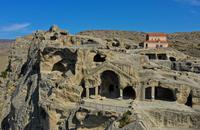Sprawling along the right bank of the Mtkvari River, the Armaziskhevi Archaeological Site (also called Armaztsikhe) forms an integral part of Mtskheta, Georgia's ancient capital. This unique complex has distinguished itself as a crucial archaeological landmark, not just for Georgia, but for the entire Caucasus region.
Armaziskhevi's rich tapestry of history spans the 1st century through to the Middle Ages, offering a treasure trove of architectural and cultural remnants. The remains of a grand palace, a bathhouse, a wine cellar, a plumbing system, a ceramics workshop, and a necropolis, along with 144 graves dating from the 2nd to the 9th centuries, lay testament to the site's erstwhile prominence.
Notably, the necropolis bore witness to the residence of the Bidakhsh dynasty, the ruling echelons of ancient Kartli, indicating that the site was once abuzz with societal activity. The graves, rich with gold and silver jewelry, coins, and various artefacts from the 2nd and 3rd centuries, further underscore the opulence of the region's inhabitants.
These precious finds are preserved across two locations: some can be explored at Armaziskhevi, while the rest are housed in the National Museum in Tbilisi. The wealth unearthed at the site offers a glimpse into the advanced culture, governance, and luxurious lifestyle of the Georgian kingdom during those centuries.
Unfortunately, the invasions led by the Persian army in the 4th century and the Arab leader Marwan II in 735 resulted in the destruction of this thriving hub. Nonetheless, the archaeological site today stands as a poignant reminder of Georgia's historical grandeur.
Positioned just 3 kilometers (about 1.9 miles) west of the Mtskheta railway station, Armaziskhevi is a unique archaeological site. It first came into prominence following the discovery of a cemetery dating back to the late Bronze-Early Iron Age. The cemetery contained tombs of the Georgian nobles Pitiakhshes, typified by tile graves, sarcophagi, and a mausoleum-style grave.
Among the significant findings at Armaziskhevi are two stelae of global importance. The first is a bilingual (Greek-Aramaic) epitaph, also known as the Sarmazian bilingual, while the second is a monolingual stela with Aramaic inscriptions, narrating the Georgians' victory in Armenia in the mid-1st century AD.
Today, Armaziskhevi offers a mesmerizing window into the past, offering an unparalleled opportunity to delve into the intricacies of Georgian history.














